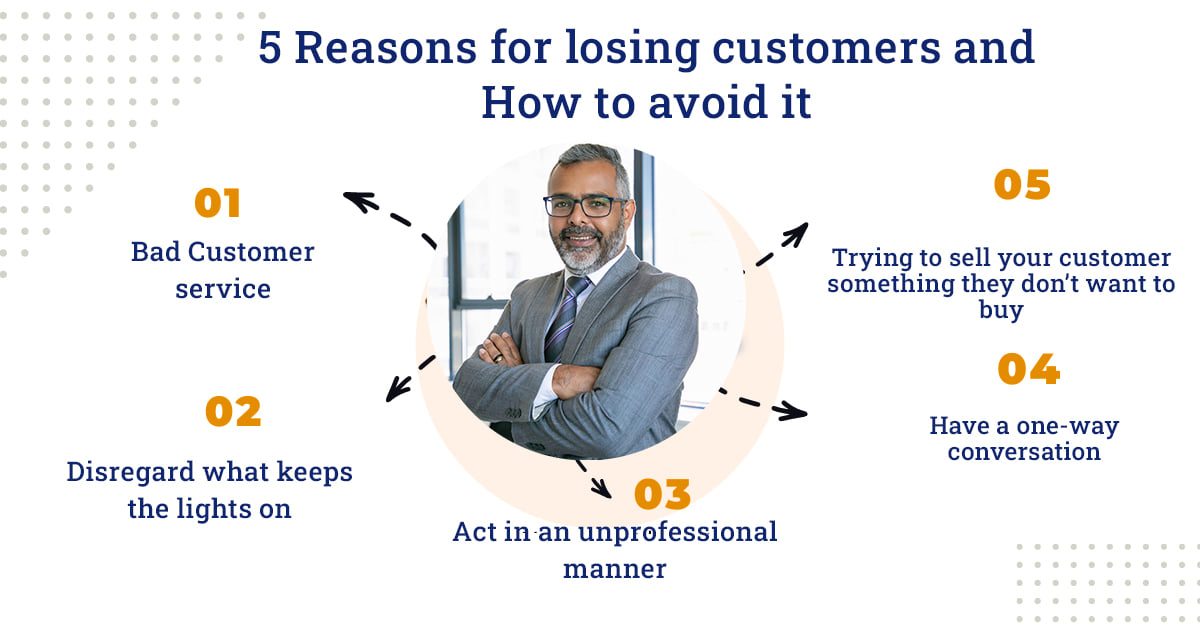5 Reasons for losing customers and How to avoid it
Table of Contents
What happens in the first few minutes of a new customer’s experience with your company often defines the success or failure of the relationship. Unfortunately, there are probably more ways to mess up those first minutes than to make them work for you. If you know what to watch out for, you can avoid falling into some all-too-familiar traps.
Here are a few of the most common reasons for losing customers.

1. Bad Customer service
Give your customer the cold shoulder if you are going to lose customers. This has happened to everyone, and it feels like the place wishes you hadn’t even come in. You walk around and wait for someone to acknowledge your presence.
Salespeople are talking with each other while you are standing only a few feet away, being completely ignored. If you want to see your customers walking across the street to your competitor, ignoring them is one of the most reliable ways of losing customers.
2. Disregard what keeps the lights on.
Every business has principal products or services that structure the business. Each business additionally has key clients that structure an foundation.
After some time key items and services; and key clients; can get underestimated while fresher, hotter, more prominent activities get all the core interest.
Make a rundown of the clients you can’t bear to lose. At that point list what those clients purchase. That rundown is the establishment of your business.
Always remember what keeps your lights on.
3. Act in an unprofessional manner.
If your customers see you acting unprofessionally about something, they will immediately begin to question whether your business is more stable than you are. What will your reaction be if they have to return something?
A calm and courteous demeanor goes a long way towards making customers feel secure about the company they are dealing with. It also reassures them that you are going to treat them in the right way if they come back to you with problems later.
4. Trying to sell your customer something they don’t want to buy.
You can talk about how good your product is, but if you can’t show your customers why they need it, it won’t matter. Many employees focus on trying to sell only those products they are most comfortable or familiar with, instead of taking the time to learn about other products and taking the trouble to find out what the customer really needs or wants.
5. Have a one-way conversation.
In other words, you dominate the conversation and don’t let your customer get a word in edgewise. It’s not only very common, it will most likely be considered rude by your customers. Put yourself in the customer’s shoes. If you met someone for the first time and that person monopolized the conversation, how would that make you feel?
Listening is the most important element of communication. A salesperson who knows what they are doing will make sure that the customer does most of the talking. This is the only way to find out what the customer came to you to buy. If you want to show your customer that you have a real interest in them and care about his or her situation, then do a lot of listening.
Finding new customers is great. The most important part of that meeting is what happens during those initial moments, after you’ve found them. One of the best way to ensure that they remember their visit fondly is to know what mistakes to avoid.
FAQs:
Some common reasons for losing customers include poor customer service, failure to meet expectations, lack of product or service quality, high prices compared to competitors, and a lack of personalized or engaging experiences.
To avoid losing customers, it’s essential to focus on providing excellent customer service, consistently delivering high-quality products or services, regularly seeking feedback and addressing customer concerns, staying competitive with pricing and value propositions, and creating personalized experiences through effective communication and relationship-building.
Customer service plays a crucial role in customer retention. By offering prompt, friendly, and helpful customer service, you can build strong relationships, address issues proactively, and enhance overall customer satisfaction. Good customer service can create loyalty and encourage customers to remain with your business.
Product or service quality is vital in retaining customers. Customers expect value for their money and a satisfactory experience. Consistently delivering high-quality offerings can build trust, credibility, and customer loyalty, ensuring they continue to choose your business over competitors.
To stay competitive with pricing, businesses should conduct market research to understand the pricing landscape, evaluate their costs and profit margins, and set prices that offer value to customers while remaining sustainable for the business. Regularly monitoring and adjusting pricing strategies can help maintain competitiveness and prevent customers from switching to cheaper alternatives.















